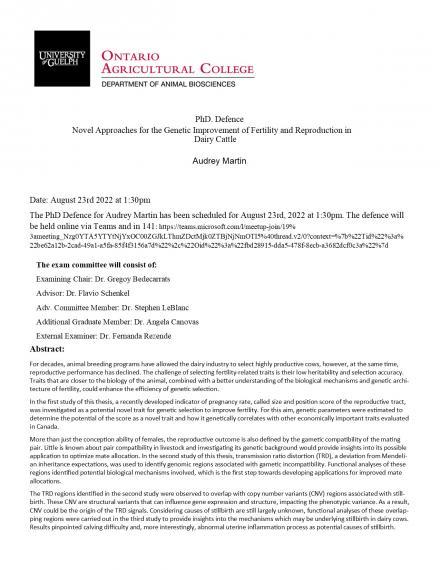Audrey Martin's PhD Defence
Date and Time
Location
Teams and room 141: https://teams.microsoft.com/l/meetup-join/19%3ameeting_Nzg0YTA5YTYtNjYxOC00ZGJkLThmZDctMjk0ZTBjNjNmOTI5%40thread.v2/0?context=%7b%22Tid%22%3a%22be62a12b-2cad-49a1-a5fa-85f4f3156a7d%22%2c%22Oid%22%3a%22fbd28915-dda5-478f-8ecb-a3682dcf0c3a%22%7d

Details
For decades, animal breeding programs have allowed the dairy industry to select highly productive cows, however, at the same time, reproductive performance has declined. The challenge of selecting fertility-related traits is their low heritability and selection accuracy. Traits that are closer to the biology of the animal, combined with a better understanding of the biological mechanisms and genetic architecture of fertility, could enhance the efficiency of genetic selection.
In the first study of this thesis, a recently developed indicator of pregnancy rate, called size and position score of the reproductive tract, was investigated as a potential novel trait for genetic selection to improve fertility. For this aim, genetic parameters were estimated to determine the potential of the score as a novel trait and how it genetically correlates with other economically important traits evaluated in Canada.
More than just the conception ability of females, the reproductive outcome is also defined by the gametic compatibility of the mating pair. Little is known about pair compatibility in livestock and investigating its genetic background would provide insights into its possible application to optimize mate allocation. In the second study of this thesis, transmission ratio distortion (TRD), a deviation from Mendelian inheritance expectations, was used to identify genomic regions associated with gametic incompatibility. Functional analyses of these regions identified potential biological mechanisms involved, which is the first step towards developing applications for improved mate allocations.
The TRD regions identified in the second study were observed to overlap with copy number variants (CNV) regions associated with stillbirth. These CNV are structural variants that can influence gene expression and structure, impacting the phenotypic variance. As a result, CNV could be the origin of the TRD signals. Considering causes of stillbirth are still largely unknown, functional analyses of these overlapping regions were carried out in the third study to provide insights into the mechanisms which may be underlying stillbirth in dairy cows. Results pinpointed calving difficulty and, more interestingly, abnormal uterine inflammation process as potential causes of stillbirth.